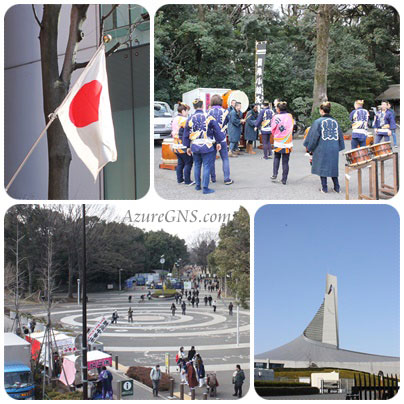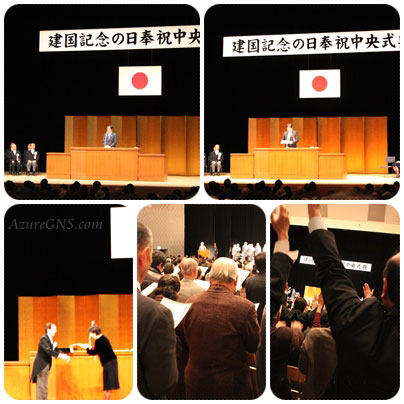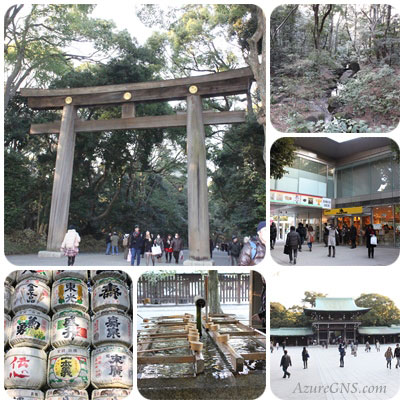Wagaya no Kenkoku-kinen-no-hi;
Our National Foundation Day Experience
学生時代、建国記念の日について教わったことはありませんでした。また、この休日について積極的にマスコミが報道することもありません。子供の頃はこの日は国民の祝日のひとつに過ぎませんでした。大人になり、インターネットが普及していろいろ情報を得ることができるようになり、徐々に日本の誕生に興味を持つようになりました。
I did not learn anything about National Foundation Day during my school days. No media has seriously focused on this holiday. It was only one of the national holidays for me when I was a child. When I grew up, the development of the internet enabled me to get a lot of information and I gradually became interested in the birth of Japan.
2013年(平成25年)2月11日の朝、急に思い立って建国記念の日をインターネットで検索してみました。渋谷で日本の建国を祝う会の主催する奉祝パレードと、奉祝中央式典が行われることを知りました。今までこのような行事について全く知らなかったので、見聞を広げるため出かけることにしました。慌てて用意をして、夫に駅まで車で送ってもらって電車で渋谷に向かいました。
On the morning of February 11th in 2013 (Heisei 25th yr), I happened to look for Kenkoku-kinen-no-hi on a search engine. I found out that a celebration parade and a celebration main ceremony would be performed by Nihon-no-Kenkoku-wo-Iwau-kai (the Committee to Celebrate Japan’s National Foundation) in Shibuya. I didn’t know anything about such an event, so I decided to attend the event to widen my knowledge. I quickly changed my clothes, asked my husband to drive me to the station and rushed to Shibuya by train.
残念ながら、午前10時から12時半まで行われたパレードには間に合いませんでした。10の大学の吹奏楽部や子供達の鼓笛隊、そして御神輿のパレードは明治公園に始まり、外苑西通り、青山通り、表参道と進み、明治神宮がゴールとなっていました。奉祝の太鼓の演奏も終わっていました。
Unfortunately, I was not in time for the parade from 10:00 am to 12:30 pm. Ten university brass bands, children’s fife and drum corps, and Mikoshi (a portable shrine) started from Meiji Park, and moved through Gaien West Street, Aoyama Street, and Omotesando and the goal was Meiji-jingu Shrine. The celebration performance of Taiko (Japanese drums) was also already finished.
JR原宿駅で下りて、歩いて10分ほどの渋谷公会堂へ急ぎました。開催時間の午後1時にぎりぎり間に合いました。入り口で1000円を払い、プログラムやチラシの入った封筒を受け取りました。
I got off the train at JR Harajuku Station and walked quickly to Shibuya Public Hall. I barely arrived before the opening time of 1:00 pm. I paid 1000 yen at the reception and received an envelope with a ceremony program and leaflets.
会場内に入るとほぼ満員で驚きました。参列者のほとんどが年配の男性でした。壇上には会の委員や政治家の方や外国からの来賓の方々が座っていました。奉祝記念行事は二部で構成されていました。第一部は奉祝中央式典で、第二部は奉祝神楽上演です。神楽とは神道において神社や通りで演じられる奉納の舞と音楽です。第一部のお話は大変興味深くて、勉強になりました。国歌と紀元節の歌の斉唱、主催者のご挨拶、ご来賓の祝辞などが行われ、最後は天皇陛下万歳の奉唱をしました。第二部では、伊勢大神楽が上演されました。伊勢大神楽は国の重要無形民俗文化財に指定されていて、獅子舞をしながらお祓いや神楽の奉納を行います。
I was surprised to find the hall was almost full of people, and most of them were elderly men. The members of the Committee, statesmen, and foreign guests were sitting on a stage. The celebration event consisted of two parts. The first part was the celebration central ceremony, and the second part was celebrated by Kagura. Kagura is sacred Shinto dance and music performed at shrines or on the streets. The speeches in the first part were very interesting for me and I learned many things. They sang the national anthem and Kigensetsu-no-uta (Song of Japan’s birthday), listened to an appreciative speech by the sponsor and congratulatory speeches by the guests. At the end of the ceremony, they cried “Long live the Emperor!” Ise-Daikagura was performed in the second part. It was designated as an important intangible folk cultural asset, in which the sacred music and dance wearing lion masks were performed for purification and oblation.
ロビーでは日本の歴史や建国に関する本が売られていました。三重県伊勢市の赤福餅が売られていました。赤福は1707年に伊勢神宮の参道の茶店で売られたのが始まりと言われています。伊勢神宮は皇室の祖神の天照大神を祀り、日本全国にある約8万の神社の本宗です。渋谷公会堂を出る時に、奉祝の紅白のお饅頭を頂きました。紅白饅頭とは餡子が中に入った赤と白の日本風の蒸しパンです。日本では赤と白の組み合わせは大概、おめでたい色とみなされます。
Books about Japanese history and foundation were sold in the lobby. Akafuku (soft rice cake covered with sweet bean paste) from Ise city, Mie Prefecture were also sold. It is said that the shop of Akafuku was established in 1707 as a tea house along the approach to Ise Shrine. Ise Shrine is dedicated to Amaterasu-omikami who is an ancestor of the Imperial family and this shrine is the foundation of the belief of about 80,000 shrines in Japan. When I left the Shibuya Public Hall, the sponsor gave me celebration Kohaku-manju: red and white Japanese style steamed buns stuffed with sweetened bean paste. The combination of red and white is usually considered auspicious in Japan.
渋谷公会堂前にはNHK(日本放送協会)があります。一人の男性が建国記念の日の報道の在り方についてNHKに対して抗議の演説をしていました。現在、NHKはこの日の意義や歴史についてほとんど報道していません。
NHK (Japan Broadcasting Corporation) is in front of the Shibuya Public Hall. One man was making a speech denouncing NHK for its attitude to National Foundation Day. Nowadays, NHK hardly reports the significance and the history of this day.
そして明治神宮へ向かうと、外国からの観光客の姿が多くみられました。明治神宮は明治天皇と昭憲皇太后を祭神とする、約70万平方メートルの広大な神社です。1912年(明治45年)に明治天皇が崩御なさると、京都の伏見桃山陵に葬られました。その後東京に神宮を建設したいという運動が東京の人々の間で起こり、彦根藩主井伊家の下屋敷の土地に約5年の歳月をかけて造られました。境内の森は日本中や、朝鮮半島や台湾からの献木が植えられたものです。約100年の歳月を経て、今では完全に自然の森のようです。初詣には毎年300万人前後が明治神宮を訪れ、参拝者数が日本一と言われています。
After that I went to Meiji-jingu Shrine and found many foreign tourists. Meiji-jingu Shrine was established to enshrine the Emperor Meiji and the Empress Shoken on the extensive grounds covering about 700 thousand square meters. In 1912 (Meiji 45th yr) the Meiji Emperor passed away and he was buried in the Imperial Mausoleum in Fushimi Momoyama in Kyoto. Afterwards, people in Tokyo started a movement for the establishment of a shrine for him in Tokyo. The shrine was built on the former site of the suburban residence of the Ii Family of Hikone Domain. It took almost five years to build the shrine. The trees donated from all over Japan, the Korean Peninsula and Taiwan were planted in the precinct forest. About 100 years have passed and now it completely looks like a natural forest. Reportedly about three million people, the largest number in Japan, visit Meiji-jingu Shrine every year to pray on New Year’s Day.
(「建国記念の日」へ戻ります。)
(Back to “National Foundation Day”)
Copyright (C) Azure Global Network Services. All Rights Reserved.




